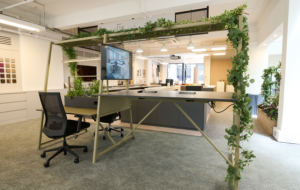
words Daniel Miller
Charlie Koolhaas’s photographs of Guangzhou, London, Dubai and Lagos reflect the contrasts of a turbulent world, says Daniel Miller.
Photographing cities is harder than it looks. Any fool can take the tourist shots. But getting a fresh angle is a tougher proposition. It’s not just a question of technical competence, but of possessing insightful positions to shoot from. But what are the insightful positions?
Charlie Koolhaas’s new urban photography exhibition at Berlin’s Aedes gallery brings out some of the issues involved. True Cities shows pictures from four major cities: London, Guangzhou, Lagos and Dubai. Each series contrasts strikingly in style and tone.
This is already clear in the show’s presentation. While the series from London and Guangzhou each merit a room, Dubai and Lagos are displayed on hooks, back-to-back.
Perhaps the scarcity of display space suggests little alternative. But still, this is unfortunate, since London and Guangzhou are shown to best advantage: the photos hang down from the ceiling, inviting visitors to lose themselves in them.
This works particularly well for Guangzhou, and the effect is amazing. Here a small room is crowded with around 50 pictures, arranged to create a kind of maze. In London the atmosphere is chillier: 18 shots in a larger space, the void blowing through them.
These arrangements reflect the content of each series. Guangzhou, where Koolhaas is presently based, is all moody light. Bursts of sky seep through an alley, a street corner blazes with neon light, a waterfall of pure white splashes through cobwebbed shadows. London is stiffer – a series of washed-out grids of colour blocks, with billboards and pavements reduced to abstract patterns.
If the images from London and Guangzhou are artful, then those from Dubai and Lagos suggest a more sociological approach. Those last two are, of course, where Koolhaas’ father Rem has focused his research. There are a great many more photos of those two cities, and their content makes it a depressing experience to go through them all.
Lagos seems to have been shot mostly from a car, while parts of Dubai appear to be shot from a helicopter. Shown back to back, their sharp contrasts are evident. Koolhaas has an eye for colour, and she uses it here to point out savage ironies. What is bright green in the glittering Gulf is a fresh, manicured lawn, while in Lagos it’s a lake of toxic slime.
Pictures of cities work in relation to other cities, an aspect clear in their people, or their absence of people. In Guangzhou there are pictures taken from the head of an alley; workers spill out and into the picture, while a young Chinese man glares at this rich Western girl’s camera. London, absent of life, appears lonely and stilted. Dubai shows two cocky and handsome young Arab guys, talking shop on a street corner. Hordes cluster in Lagos beneath rotting highways.
Are these cities true cities? Koolhaas’s position shifts radically. Dubai and Lagos are clearly highly critical, but the criticism is tied to a specific perspective. To her credit, and by showing four cities rather than one, Koolhaas presents this fact openly, and underscores the complexity of some troubling issues. In general, this quartet is highly pessimistic. Guangzhou is as beautiful as a film about murder. London is solitude. Dubai is Babylon. Lagos is hell.
True Cities is at the Aedes Gallery, Berlin, until 26 March















